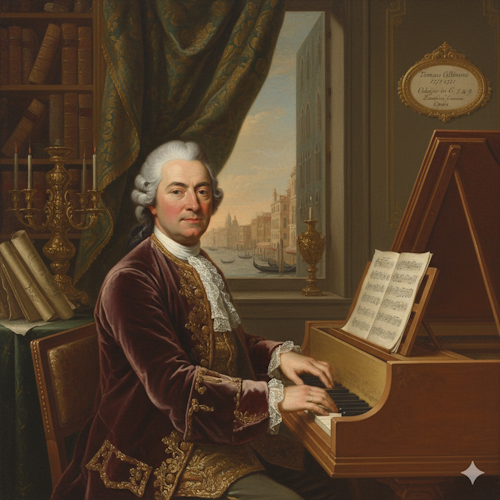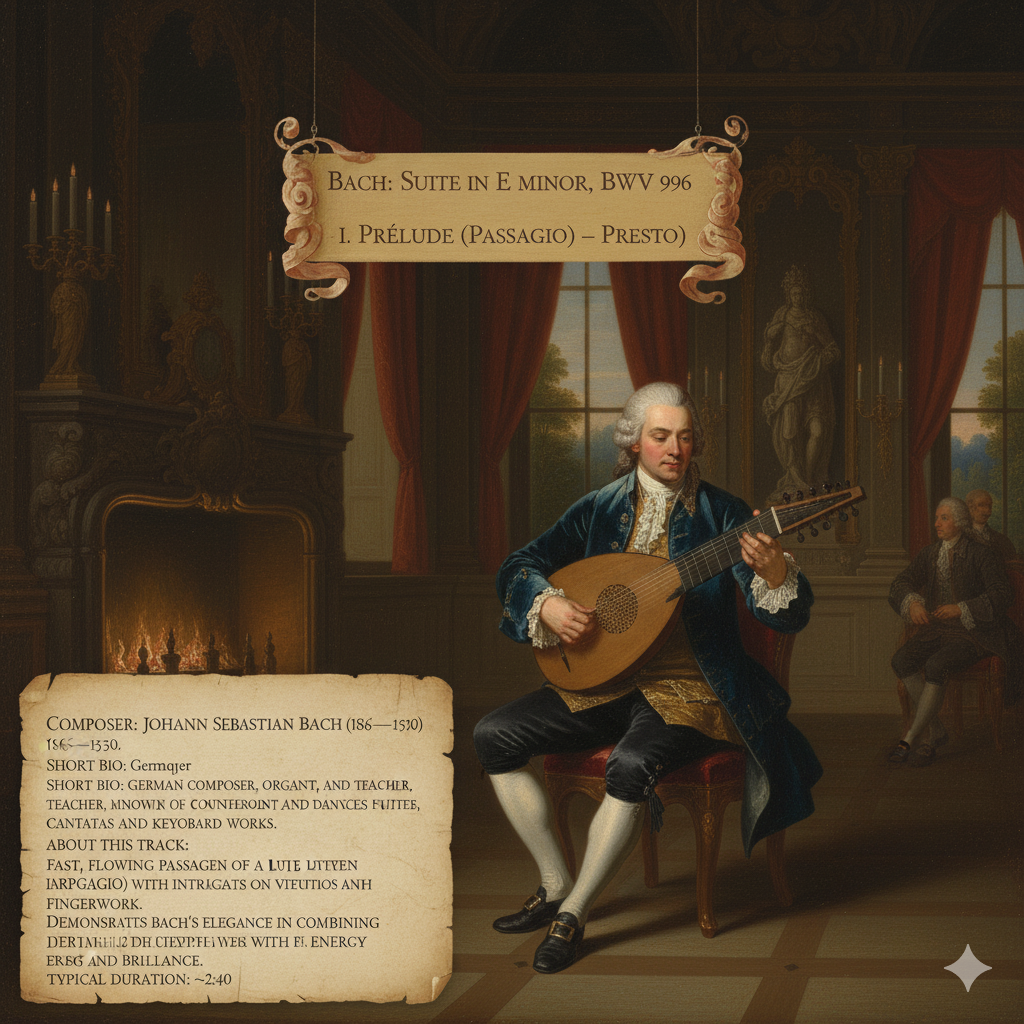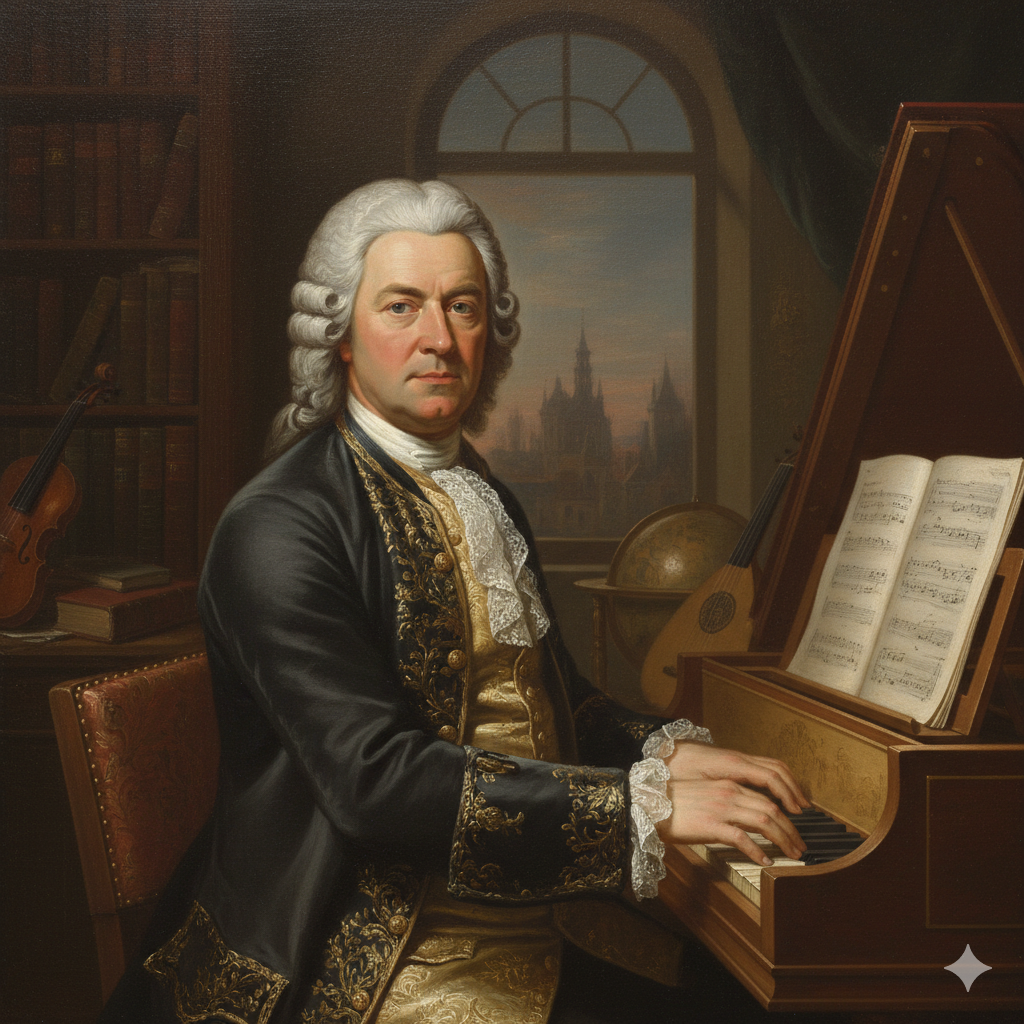| Select | Composer | Work | Duration | Controls |
|---|---|---|---|---|
|
Tomaso Giovanni Albinoni (1671–1751)
×

Tomaso Giovanni Albinoni (1671–1751) Nationality: Italian Biography & Career Highlights:
Notable Works:
Legacy:Albinoni’s music is admired for its lyrical and expressive qualities, widely used in film and recordings. Contributed significantly to the development of the Baroque concerto, especially for the oboe. |
Op.5 No.1 in B♭, I. Allegro Moderato | 02:06 | ||
|
Johann Sebastian Bach 1685–1750
×
 Bach: Concerto for Harpsichord, Strings, and Continuo No. 5 in F minor, BWV 1056 — II. Largo
Composer Summary — Johann Sebastian Bach
Name: Johann Sebastian Bach
Lifespan: 1685–1750
Era: Baroque
Short bio: German composer, organist, and teacher. Renowned for counterpoint and harmonic mastery. His keyboard concertos, including BWV 1056, show expressive lyricism, intricate textures, and elegant melodic writing.
Notable features (Concerto No.5, mvt II, Largo): slow, lyrical movement; expressive harpsichord solos intertwined with strings; contemplative and serene mood.
Bach: Concerto for Harpsichord, Strings, and Continuo No. 5 in F minor, BWV 1056 — II. Largo
Composer Summary — Johann Sebastian Bach
Name: Johann Sebastian Bach
Lifespan: 1685–1750
Era: Baroque
Short bio: German composer, organist, and teacher. Renowned for counterpoint and harmonic mastery. His keyboard concertos, including BWV 1056, show expressive lyricism, intricate textures, and elegant melodic writing.
Notable features (Concerto No.5, mvt II, Largo): slow, lyrical movement; expressive harpsichord solos intertwined with strings; contemplative and serene mood.
|
Concerto For Harpsichord, Strings, And Continuo No.5 In F Minor, BWV 1056 _ 2. Largo | 02:57 | ||
|
Johann Sebastian Bach (1685–1750)
×
 Composer: Johann Sebastian Bach (1685–1750)
Era: Baroque
Short bio: German composer, organist, and teacher. Master of counterpoint and dance forms, known for suites, concertos, cantatas, and keyboard works.
About this track:
Suite in E Minor, BWV 996 — I. Prélude (Passagio) – Presto
Opening movement of a suite for lute (often performed on guitar or harpsichord).
Fast, flowing passages (passagio) with intricate arpeggios and virtuosic fingerwork.
Demonstrates Bach’s elegance in combining harmonic depth with rhythmic drive.
Sets the tone for the following suite movements with energy and brilliance.
Typical duration: ~2:40
Composer: Johann Sebastian Bach (1685–1750)
Era: Baroque
Short bio: German composer, organist, and teacher. Master of counterpoint and dance forms, known for suites, concertos, cantatas, and keyboard works.
About this track:
Suite in E Minor, BWV 996 — I. Prélude (Passagio) – Presto
Opening movement of a suite for lute (often performed on guitar or harpsichord).
Fast, flowing passages (passagio) with intricate arpeggios and virtuosic fingerwork.
Demonstrates Bach’s elegance in combining harmonic depth with rhythmic drive.
Sets the tone for the following suite movements with energy and brilliance.
Typical duration: ~2:40
|
Suite In E Minor, BWV 996 _ 1. Prélude (Passagio) - Presto | 02:45 | ||
| Antonio Vivaldi (1678–1741) | Lives of the Great Baroque Composers – Vivaldi | 03:15 | ||
| George Frideric Handel (1685–1759) | Lives of the Great Baroque Composers – Handel | 05:08 | ||
| Tomaso Albinoni (1671–1751) | Lives of the Great Baroque Composers – Albinoni | 03:53 | ||
| Antonio Stradivari (1644–1737) | Lives of the Great Baroque Masters – Stradivari | 06:13 | ||
|
Sebastian Bach (1685–1750)
×

Brandenburg Concerto No. 3 in G major, BWV 1048
|
Brandenburg Concerto No. 3 in G major, BWV 1048 | 04:27 | ||
|
Johann Sebastian Bach - 1685–1750
×
 Brandenburg Concerto No. 2 in F, BWV 1047 — I. Allegro,
Composer summary — Johann Sebastian Bach
Name: Johann Sebastian Bach
Lifespan: 1685–1750
Era: Baroque
Short bio: German composer, organist and teacher. Master of counterpoint and fugal writing; wrote cantatas, concertos, keyboard works, and large-scale sacred works. The Brandenburg Concertos (published 1721) are a set of six instrumental concertos showcasing different instrumental groupings and virtuosic writing.
Notable features (Brandenburg No.2, mvt I): lively ritornello form, brilliant trumpet/oboe/flute/violin solo writing, fast-moving counterpoint and lively dance-like rhythms.
Brandenburg Concerto No. 2 in F, BWV 1047 — I. Allegro,
Composer summary — Johann Sebastian Bach
Name: Johann Sebastian Bach
Lifespan: 1685–1750
Era: Baroque
Short bio: German composer, organist and teacher. Master of counterpoint and fugal writing; wrote cantatas, concertos, keyboard works, and large-scale sacred works. The Brandenburg Concertos (published 1721) are a set of six instrumental concertos showcasing different instrumental groupings and virtuosic writing.
Notable features (Brandenburg No.2, mvt I): lively ritornello form, brilliant trumpet/oboe/flute/violin solo writing, fast-moving counterpoint and lively dance-like rhythms.
|
Brandenburg Concerto No.2 in F, BWV 1047 _ 1. (Allegro) | 04:48 | ||
|
Johann Sebastian Bach-1685–1750
×
 Brandenburg Concerto No. 2 in F, BWV 1047 — 2. Andante
Composer summary — Johann Sebastian Bach
Name: Johann Sebastian Bach
Lifespan: 1685–1750
Era: Baroque
Short bio: German composer, organist and teacher. Master of counterpoint and fugal writing; wrote cantatas, concertos, keyboard works, and large-scale sacred works. The Brandenburg Concertos (published 1721) are a set of six instrumental concertos showcasing different instrumental groupings and virtuosic writing.
Notable features (Brandenburg No.2, mvt I): lively ritornello form, brilliant trumpet/oboe/flute/violin solo writing, fast-moving counterpoint and lively dance-like rhythms.
Brandenburg Concerto No. 2 in F, BWV 1047 — 2. Andante
Composer summary — Johann Sebastian Bach
Name: Johann Sebastian Bach
Lifespan: 1685–1750
Era: Baroque
Short bio: German composer, organist and teacher. Master of counterpoint and fugal writing; wrote cantatas, concertos, keyboard works, and large-scale sacred works. The Brandenburg Concertos (published 1721) are a set of six instrumental concertos showcasing different instrumental groupings and virtuosic writing.
Notable features (Brandenburg No.2, mvt I): lively ritornello form, brilliant trumpet/oboe/flute/violin solo writing, fast-moving counterpoint and lively dance-like rhythms.
|
Brandenburg Concerto No.2 in F, BWV 1047 2 Andante | 04:07 | ||
|
Johann Sebastian Bach-1685–1750
×
 Brandenburg Concerto No. 2 in F, BWV 1047 — 3. Allegro assai
Composer summary — Johann Sebastian Bach
Name: Johann Sebastian Bach
Lifespan: 1685–1750
Era: Baroque
Short bio: German composer, organist and teacher. Master of counterpoint and fugal writing; wrote cantatas, concertos, keyboard works, and large-scale sacred works. The Brandenburg Concertos (published 1721) are a set of six instrumental concertos showcasing different instrumental groupings and virtuosic writing.
Notable features (Brandenburg No.2, mvt I): lively ritornello form, brilliant trumpet/oboe/flute/violin solo writing, fast-moving counterpoint and lively dance-like rhythms.
Brandenburg Concerto No. 2 in F, BWV 1047 — 3. Allegro assai
Composer summary — Johann Sebastian Bach
Name: Johann Sebastian Bach
Lifespan: 1685–1750
Era: Baroque
Short bio: German composer, organist and teacher. Master of counterpoint and fugal writing; wrote cantatas, concertos, keyboard works, and large-scale sacred works. The Brandenburg Concertos (published 1721) are a set of six instrumental concertos showcasing different instrumental groupings and virtuosic writing.
Notable features (Brandenburg No.2, mvt I): lively ritornello form, brilliant trumpet/oboe/flute/violin solo writing, fast-moving counterpoint and lively dance-like rhythms.
|
Brandenburg Concerto No.2 in F, BWV 1047 _ 3. Allegro assai | 02:52 | ||
| Arcangelo Corelli (1653–1713) | Concerto Grosso in D major, Op. 6 No. 1 - I. Largo - Allegro | 02:22 | ||
| Arcangelo Corelli (1653–1713) | Concerto Grosso in D major, Op. 6 No. 1 - II. Largo - Allegro | 02:48 | ||
| Arcangelo Corelli (1653–1713) | Concerto Grosso in D major, Op. 6 No. 1 - III. Largo | 03:16 | ||
| Arcangelo Corelli (1653–1713) | Concerto Grosso in D major, Op. 6 No. 1 - IV. Allegro | 01:52 | ||
| Arcangelo Corelli (1653–1713) | Concerto Grosso in F major, Op. 6 No. 2 - I. Vivace - Allegro | 03:27 | ||
| Arcangelo Corelli (1653–1713) | Concerto Grosso in F major, Op. 6 No. 2 - II. Largo - Andante | 00:54 | ||
| Arcangelo Corelli (1653–1713) | Concerto Grosso in F major, Op. 6 No. 2 - III. Allegro | 01:48 | ||
| Antonio Vivaldi (1678–1741) | The Four Seasons: Autumn: Adagio | 02:40 | ||
| Antonio Vivaldi (1678–1741) | 4 Seasons Spring – Allegro | 02:50 | ||
| Antonio Vivaldi (1678–1741) | 4 Seasons Spring – II. Largo | 03:20 | ||
| Antonio Vivaldi (1678–1741) | 4 Seasons Spring – III. Allegro | 02:45 |



